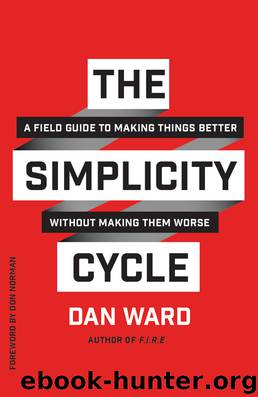The Simplicity Cycle: A Field Guide to Making Things Better Without Making Them Worse by Dan Ward

Author:Dan Ward
Language: eng
Format: mobi
Publisher: HarperCollins
Published: 2015-05-11T14:00:00+00:00
FIGURE 19: WHERE AM I?
Our specific location in the “Where Am I?” cloud at any moment in time is less important than our trajectory. Rather than asking, “Where am I?” we should focus on figuring out, “Where am I going?” In engineering terms, our vector matters more than our position and the important thing to identify is whether the latest change to the design makes it better or worse.
One reason our location does not matter much is that the prescribed behaviors for the upper left corner are essentially identical to the prescribed behaviors for the center of the chart. In both cases, improvements require integration, simplification, and streamlining. So don’t spend too much time trying to narrow down a precise location. Think instead in terms of where we’re heading.
Keep in mind that when we talk about the design process, we’re largely talking about making changes to the design. We add things or subtract them, making our object simpler or more complex. So the question is whether the transition from version 1.3 to version 1.4 represents an improvement or merely a complexification. Did our trajectory carry us toward the right, in the direction of increased goodness, or toward the left, where goodness decreases?
The answers to these questions help us identify what type of design behaviors we should adopt next. If our previous step made things more complicated and worse, our next step should probably involve simplification. But if the previous step made things better, we may want to continue along that former path.
Now, if there is one point we could try to identify, it’s the “peak of complexity,” the point of critical mass where increases in complexity reduce goodness. How can we tell if we’re there?
The short answer: we can’t. Cliff Crego explains:
Where the climax of complexity comes we can never know for sure, but natural movement always begins and ends with simplicity.
Download
This site does not store any files on its server. We only index and link to content provided by other sites. Please contact the content providers to delete copyright contents if any and email us, we'll remove relevant links or contents immediately.
| Automotive | Engineering |
| Transportation |
Whiskies Galore by Ian Buxton(40330)
Introduction to Aircraft Design (Cambridge Aerospace Series) by John P. Fielding(32338)
Small Unmanned Fixed-wing Aircraft Design by Andrew J. Keane Andras Sobester James P. Scanlan & András Sóbester & James P. Scanlan(32141)
Craft Beer for the Homebrewer by Michael Agnew(17446)
Turbulence by E. J. Noyes(7039)
The Complete Stick Figure Physics Tutorials by Allen Sarah(6638)
Kaplan MCAT General Chemistry Review by Kaplan(6053)
The Thirst by Nesbo Jo(5785)
Bad Blood by John Carreyrou(5769)
Learning SQL by Alan Beaulieu(5411)
Weapons of Math Destruction by Cathy O'Neil(5036)
Man-made Catastrophes and Risk Information Concealment by Dmitry Chernov & Didier Sornette(4735)
iGen by Jean M. Twenge(4702)
Digital Minimalism by Cal Newport;(4540)
Life 3.0: Being Human in the Age of Artificial Intelligence by Tegmark Max(4507)
Audition by Ryu Murakami(4099)
1,001 ASVAB Practice Questions For Dummies by Powers Rod(4038)
Electronic Devices & Circuits by Jacob Millman & Christos C. Halkias(4027)
Pale Blue Dot by Carl Sagan(4001)
